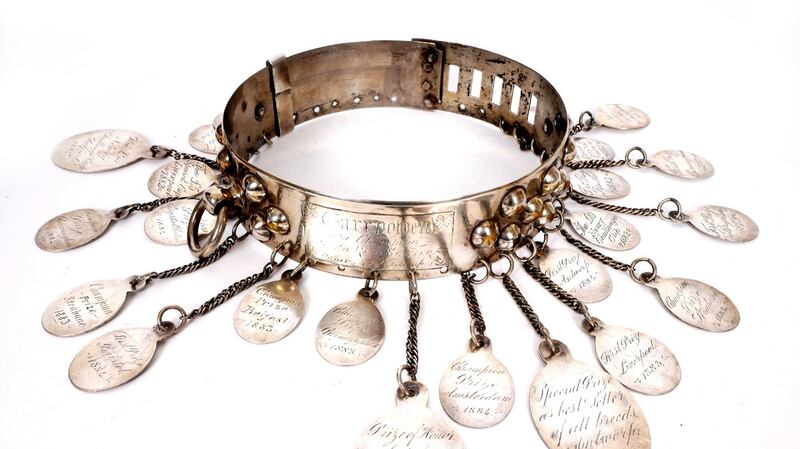Every second programme on television these days seems to be devoted to every aspect of dogs you could ever dream up – and a few you couldn’t. But canine celebrity is nothing new. In 1884 an Irish red setter took the top prize at the Belgian Kennel Club show in Antwerp, beating 978 sporting dogs of all breeds.
His name was Garryowen, and he was so famous that he had a brand of tobacco named after him, got three mentions in Ulysses, sired innumerable offspring, had his portrait painted and, when he finally went to that great doggy daycare in the sky, had his obituary published in the Chicago Tribune.
Garryowen’s owner, James Giltrap – a great uncle of James Joyce – was so proud of Garryowen that he commissioned a silver champion’s collar hung with medals representing each of the dog’s victories. “You can just see him rocking up to a show wearing his collar – like a heavyweight champion coming into the ring to defend his title,” says Stuart Purcell of Whyte’s.
The collar forms Lot 32 in Whyte’s Eclectic Collector auction on May 6th, with an estimate of €800-€1,200. There are also three enamel advertising signs, Lots 145-147, featuring Garryowen plug tobacco, with estimates from €150 to €400.

Eclectic sale
This sale isn’t called “eclectic” for nothing: the catalogue includes banknotes, military memorabilia, Fianna Fáil election posters from the 1940s, photographs from the John Minihan archive and a lustreware jug with a portrait of Daniel O’Connell. The latter, Lot 23, has an estimate of €800 to €1,200.
Maps and posters are a major feature. A 1685 map of New England (Lot 538, estimate €2,500-€3,000) includes a view of a small coastal town called New Amsterdam in which the tallest visible buildings are a windmill and a church – the second earliest image of New York city ever to be printed on a piece of paper.

A 1632 map of Ireland by the British cartographer John Speed, in a double-sided frame with descriptions of the country on the reverse side, (Lot 516, €1,000 to €1,500) looks surprisingly accurate – apart from the conspicuous absence of Connemara, Achill and the Mullet Peninsula. “Here be dragons and wild Irish people – that was essentially the approach to Connacht in those days,” Purcell says.
Lot 152 – a 1903 railway poster of Donegal with views of Slieve League, Killybegs and a train passing through Barnsmore Gap by moonlight – may turn out to be a sleeper. “We have it on quite conservatively at €300 to €500, but if the railway guys get on to it, it could take off,” Purcell says.

Personal stories
Some of the stories told by collectibles are poignant and personal.
A tiny cup presented to Joseph Rankin for his defence of Trinity College Dublin during the 1916 Rising is accompanied by another cup dating from two years earlier. It was awarded to Rankin’s son, who won it for being best shot in his intake of British army recruits – only to be killed in the opening year of the first World War.
“Something like this connects you right back to that moment in history,” says Purcell. “You can understand how, having lost his son, he might have been defending the college in the name of the crown.” (Lot 63, 2,500 to €3,000)
Lot 241, a Japanese sword, harbours a more sinister secret. “Part of the policy of the demilitarisation of Japan after the second World War was the destruction of all weapons,” Purcell explains. The Allies did not distinguish between a factory-made sword and a blade which might have been hand-forged in the 15th century, so huge numbers of swords were destroyed in specially-built smelting furnaces. They are now, of course, highly prized by collectors.
Lot 243, the earliest sword in the sale, dates from the 17th century: in a plain wood scabbard, it is engraved with a dragon pursuing the pearl of wisdom (estimate €2,000-€3,000). Lot 240 is a court sword in a decorated scabbard (1,710-2,560) But it’s Lot 241 that Purcell describes as “truly bloodcurdling. The blade is frighteningly sharp. The handle can be removed by means of a bamboo peg: underneath, there’s a maker’s name and text which, when translated, reads, ‘Cut through a head and into the earthen mound below’.”
The head in question was attached to a corpse rather than a living person – still, the shiver induced by the inscription may inspire this sword to make more than its estimate of €3,000-€5,000.
More cheery
Time for something a little more cheery: an innocent-looking black tin case which opens to reveal a Victorian portable gaming set. With its elegant, ivory-handled mahogany roulette wheel, the table may have been in use as recently as the 1950s at point-to-points, fairs and carnivals.
“As quickly as it can open out, it can be put away again, in case the boys in blue put in an unwelcome appearance,” says Purcell. “Yes, officer? Nothing to see here, officer…” Lot 33 carries an estimate of €400 to €600.
The Eclectic Collector sale is at the Freemasons Hall, 17 Molesworth Street, Dublin 2, on May 6th at 10am. Viewing at Whyte's, 38 Molesworth Street, May 3rd-5th, 10 am-5 pm. See whytes.ie










